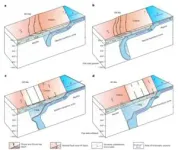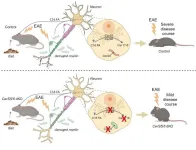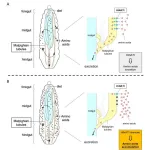China University of Geosciences (Beijing) unveils clues to an enigmatic geological process
Using advanced computational models, researchers explain how the North China Craton, an ancient and stable geological structure, is falling apart
2024-11-01
(Press-News.org)
Cratons are fascinating yet enigmatic geological formations. Known to be relatively stable portions of the Earth’s continental crust, cratons have remained largely unchanged for billions of years. Although cratons have survived many geological events, some are undergoing decratonization—a process characterized by their deformation and eventual destruction. For example, the North China Craton (NCC), an ancient continental crust block, is known to have begun extensive decratonization during the Mesozoic era, largely due to tectonic and geochemical modifications and destabilization of its base (or ‘keel’). However, explaining the mechanisms behind these complex geological transformations has proven difficult with existing techniques and current understanding.
In a recent study published in volume 17 of Nature Geoscience on September 6, 2024, a research team led by Professor Shaofeng Liu from China University of Geosciences (Beijing) successfully addressed this knowledge gap. As explained in their paper, the researchers developed a computational model supported by extensive geological, geophysical, and empirical geochemical data that explains the puzzling deformation of the NCC. Moreover, for a better understanding of the mechanism, an animated video illustrating the model’s dynamics and implications is also available.
Specifically, the developed model focuses on the subduction of the Izanagi plate beneath the Eurasian plate, where the NCC is located, as the reason underlying the observed decratonization. The researchers compared several possible subducted plate geometries using earthquake seismicity and basin stratigraphy evidences to narrow down potential reconstructions. Finally, using their geodynamic mantle-flow model, they simulated the full extent of the subduction process and validated the predictions empirically.
Their analysis explains the decratonization of the NCC in three phases. First, the Izanagi plate underwent initial subduction and slid beneath the Eurasian plate. However, instead of progressing downward, the Izanagi plate flattened and started moving parallel to the Eurasian plate, in a process called flat-slab subduction. Fluids from the subducted plate altered the NCC’s keel above, initiating its destruction. Moreover, squeezing forces caused other deformations, such as thrusting, craton thickening, and surface uplift.
Interestingly, there was then a rollback process, as a result of which the subducted plate steepened again and progressed deeper below the Eurasian plate, reaching the upper-lower mantle interface and undergoing horizontal subduction into the mantle transition zone. This rollback caused extensional deformation, resulting in thinning of the lithosphere and the formation of rift basins with surface topographic lowing on the craton. Additionally, a large region of upper mantle material, known as a ‘large mantle wedge,’ developed between the advancing slab and the craton, leading to convection that can induce intense metasomatism and partial melting along with heating and erosion at the base of the sub-craton, as well as magmatism.
Speaking to us about these findings. Prof. Liu says, “We successfully developed a new mantle-flow model incorporating flat-slab and rollback subduction, which aligns with surface geological evolution and the present-day mantle slab structure.” Adding further, he says, “Interestingly, our validated model can effectively describe the space–time dynamics and topographic response of mantle slab subduction over time.”
Given that cratons contain mineral and rare-earth element deposits with immense value for technological applications, understanding the life cycle of cratons is important from both an academic and a practical standpoint. Building on these insights, further inquiries into the geological history of our planet will hopefully lead us to a deeper understanding of geological processes like decratonization, revealing paths towards a more sustainable future.
***
Reference
DOI: https://doi.org/10.1038/s41561-024-01513-2
END
[Attachments] See images for this press release:


ELSE PRESS RELEASES FROM THIS DATE:
2024-11-01
Despite ongoing efforts to curb CO2 emissions with electric and hybrid vehicles, other forms of transportation remain significant contributors of greenhouse gases. To address this issue, old technologies are being revamped to make them greener, such as the reintroduction of sailing vessels in shipping and new uses for hydrogen in aviation. Now, researchers reporting in ACS Sustainable Chemistry & Engineering have used computer modeling to study the feasibility and challenges of hydrogen-powered aviation.
“While there is a long way to go for hydrogen aviation to be realized at scale, we hope that our ...
2024-11-01
Socioeconomic factors such as education, occupation, and wealth influence the likelihood of developing cognitive impairment or dementia in later life and whether a person is likely to recover, finds a new study led by UCL researchers.
The research, published in Scientific Reports, followed 8,442 adults aged 50 and above in England over 10 years from 2008/09 to 2018/19, to examine how socioeconomic factors at the start of the study were associated with changes in cognitive status.
The researchers tracked how these people moved between various states: healthy, mild cognitive impairment, and dementia. They also considered the possibility ...
2024-11-01
Getting to the heart of causality is central to understanding the world around us. What causes one variable — be it a biological species, a voting region, a company stock, or a local climate — to shift from one state to another can inform how we might shape that variable in the future.
But tracing an effect to its root cause can quickly become intractable in real-world systems, where many variables can converge, confound, and cloud over any causal links.
Now, a team of MIT engineers hopes to provide some clarity in the pursuit of causality. They developed ...
2024-11-01
About The Study: This article discusses a recent revision of the Alzheimer Association criteria to define Alzheimer disease (AD) as a purely biological entity, which raises concerns that if diagnosis of AD can be reduced to the sole presence of AD core 1 biomarkers, major uncertainty and variability in the clinical prognosis of patients diagnosed with AD may be introduced.
Corresponding Author: To contact the corresponding author, Bruno Dubois, MD, MSc, email bruno.dubois@aphp.fr.
To access the embargoed study: Visit our For The Media website at this link https://media.jamanetwork.com/
(doi:10.1001/jamaneurol.2024.3770)
Editor’s ...
2024-11-01
The EULAR 2025 Congress will gather the world's foremost rheumatology experts, fostering a unique environment to explore pioneering research, clinical advancements, and patient-centred innovations in rheumatology. This annual flagship event offers unparalleled access to transformative discussions and showcases the latest strides in patient care for rheumatic and musculoskeletal diseases (RMDs).
This year's Congress programme promises an impressive line-up, featuring must-see scientific sessions, EULAR Recommendations, and insightful abstract presentations. Esteemed speakers from across Europe and beyond ...
2024-11-01
NEW YORK, November 1, 2024 — Newly published research in the journal Glia has identified crucial links between dietary choices and the progression of multiple sclerosis (MS). The study, led by Patrizia Casaccia, founding director of the Advanced Science Research Center at the CUNY Graduate Center’s (CUNY ASRC) Neuroscience Initiative and Einstein Professor of Biology and Biochemistry at the CUNY Graduate Center, explored how enzymes called ceramide synthase 5 and 6 are responsible for the toxic effect ...
2024-11-01
With the rapid increase in the global population, a "protein crisis" is expected in the near future, where the supply of protein will not be able to meet the rising demand. Fishmeal is the most common protein source that supports the production of livestock and aquaculture products, which are key protein sources for human consumption. However, global shortage of fishmeal and its rising prices have created an urgent need to find and secure an alternative protein source. Insects are gaining attention as novel protein sources ...
2024-11-01
Most women use medication during pregnancy. Yet, selecting appropriate drugs and doses is challenging. In a new The Lancet article, physicians and researchers from the Radboud university medical center, Maastricht UMC+, Imperial College London, and the University of Liverpool introduce a shared decision-making approach combining ethical principles and a pregnant woman’s values with existing evidence. They use the example of sertraline, a commonly prescribed antidepressant in pregnancy, to illustrate the advocated decision-making process.
Although pregnant women often need medication, data on drug safety and efficacy in pregnancy remains limited. Historically seen as vulnerable research ...
2024-10-31
Summary:
Texas Tech’s Natasja van Gestel has been named Station Science Leader by the National Science Foundation (NSF), enabling her to lead and coordinate research at Antarctica’s Palmer Station while advancing her work on climate change’s impact on glaciers. As a leader, she will oversee multiple scientific initiatives, manage resources and ensure compliance with the Antarctic Treaty’s regulations.
Why This Matters:
Climate Study: Her research contributes vital data on climate change effects in Antarctica, crucial for global climate assessments.
International Collaboration: ...
2024-10-31
A low-sugar diet in utero and in the first two years of life can meaningfully reduce the risk of chronic diseases in adulthood, a new study has found, providing compelling new evidence of the lifelong health effects of early-life sugar consumption.
Published in Science, the study finds that children who experienced sugar restrictions during their first 1,000 days after conception had up to 35% lower risk of developing Type 2 diabetes and as much as 20% less risk of hypertension as adults. Low sugar intake by the mother prior to birth was enough to lower risks, but ...
LAST 30 PRESS RELEASES:
[Press-News.org] China University of Geosciences (Beijing) unveils clues to an enigmatic geological process
Using advanced computational models, researchers explain how the North China Craton, an ancient and stable geological structure, is falling apart



